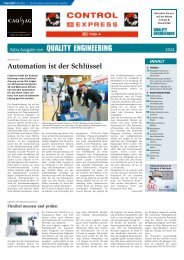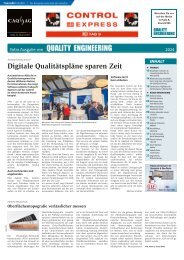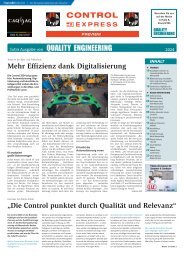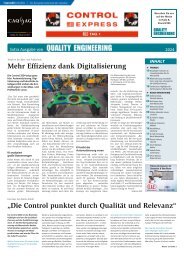EPP Europe P2.2022
You also want an ePaper? Increase the reach of your titles
YUMPU automatically turns print PDFs into web optimized ePapers that Google loves.
COVER STORY » CCI SOLUTIONS<br />
The overlay of reference signal and measurement signal creates a convergence signal caused by reflections at the refraction lines.<br />
The distance between the convergence peaks is the height of the material.<br />
Source: Koh Young<br />
3D inspection<br />
Until recently, 2D inspection was all that was<br />
required for conformal coating inspection; now however,<br />
there is rising demand for 3D inspection. This<br />
has come about because it is necessary to ensure the<br />
coating attains a particular thickness. If the conformal<br />
coating is applied too thinly, the parts that<br />
require protection may not be sufficiently shielded.<br />
If, on the other hand, the coating is applied too<br />
thickly, the unnecessary stress this adds to the board<br />
can cause side effects such as bubbles and cracks.<br />
“Proper coating thickness is very<br />
important to ensure the quality of a board<br />
yet 3D thickness inspection is not easy<br />
because the coating itself is transparent.”<br />
IPC recommends a thickness of between 30um and<br />
130um depending on the type of conformal coating.<br />
Proper coating thickness is very important to ensure<br />
the quality of a board, yet 3D thickness inspection is<br />
not easy because the coating itself is transparent.<br />
Biggest inspection challenges<br />
So, what are the biggest challenges when it<br />
comes to coating inspection? Conformal coatings<br />
are done using different materials meaning that, in<br />
some cases, the coating thickness and UV color<br />
may be different – even for the same type of board.<br />
As conventional 2D CCI (conformal coating inspection)<br />
systems inspect according to the UV color,<br />
and are susceptible to the board environment, this<br />
can lead to a high rate of 2D false calls. In order to<br />
solve these problems, it is also necessary to continuously<br />
draw and set the region of interest (ROI).<br />
Finally, as explained above, because the conformal<br />
coating is itself transparent, 3D thickness measurement<br />
using existing inspection technology becomes<br />
a challenge. In the case of IC components, for instance,<br />
we find that, because the coating flows<br />
down, it remains thin on top of the leads but<br />
relatively thick in between them because it has gathered<br />
here.<br />
In the case of underfill, there is a need to check the<br />
fillet height using 3D. Accurate measurement is difficult<br />
due to the steep slope of the fillet. Although, it<br />
looks black, underfill may, in some cases, have some<br />
transparency. Before curing especially, it is even<br />
18 <strong>EPP</strong> <strong>Europe</strong> » 11 | 2022

















